
Here you are, facing those vast, dark expanses of sky! What to see. How to proceed? Just follow the main tutorial below, 'Touring the Summer Night Skies, a Guide', while using the appropriate charts. You will note that we assume that you know where the South, North, West and East are, relative to your observation location (that's easily found with a compass, or with a chart). The charts, further, are given for 10:30 p.m. local time -which is the usual time for which the night sky charts, usually, are given. The color charts are added with printer-friendly charts as it's mostly those latter ones that you'll like to take with you on the field
At last, in any case, read the three following remarks, which are mandatory for a better use of our tutorials:
- note #1: we assume that you know where the South, North, West and East are, relative to your observation location (that's easily found with a compass, or with a chart). The charts, further, are given for 10:30 p.m. local time -which is the usual time for which the night sky charts, usually, are given. The detailed color charts are added with printer-friendly charts as it's mostly those latter ones that you'll like to take with you on the field
-note #2: you will note that, as far as our site's charts are concerned, they do not bear, by a worry of legibility, any name of the bright stars. As our description refer to such names, just consider that those mostly are, on the chart, the brightest star of a constellation in question
- note #3: you'll note that you may have to apply some correction to any chart, function of the DST or ST you have at your location. Our site is applying a uniform 1-hour DST time shift, from April to October in the northern hemisphere, with the charts reflecting that choice
- note #4: a current tendency of the astronomical softwares and charts is to shift from the constellations' shapes as they are usually defined and recognized by the amateur astronomy community. The following color charts on this page are those which are shifting the most in this regard, as the printer-friendly charts are those who do less and are the ones to be used to memorize the basic shapes of the constellations, albeit still not completely accurate. read more!
| Touring the Summer Night Skies, a Guide | Hemispherical Sky Charts |
One of the most remarkable traits of the skies in the southern hemisphere is a large band of Milky Way-embedded typically southern constellations. During summer, that band is seen southeast. Thus, we'll begin the tour there
With a view conspicuous, just see how, from the horizon to the zenith, that magnificent view of the Milky Way is unfolding, with those southern constellations and bright stars embedded there! Let's begin with the famed sight, in the southern hemisphere, of Crux, the Southern Cross. First, spot those both stars which are called the 'Pointers', few above the horizon. From left to right those are Agena, and Alpha Centauri. The 'Pointers', in the southern hemisphere features this pecularity that they allow for finding Crux, the Southern Cross. It's enough, in the reverse order than above, to extend the direction they give, by about twice de distance between them. And here we are at Crux! Crux, the Southern Cross -the sky's smallest- has a distinctive form of a small cross. As the constellation, in the past, was visible from some parts of the northern hemisphere, the astronomers of the Antiquity had, first, attributed those stars to the constellation of Centaurus, the Centaur. It seems like it is the explorer Amerigo Vespucci who, first, designed Crux like an independent constellation. The famed characteristic of Crux, the Southern Cross is that, in the southern hemisphere, it's an easy way to spot where the southern celestial pole is. It is just where you land when you extend -now right and slightly upwards- the main axis of Crux, at about 5 times the axis' length. This region of the sky is dark and void of any bright star. To the lower right of the Crux's star which is on the side of the celestial pole, is to be found the 'Coalsack', an interstellar cloud which blocks the light of stars located beyond. Should we now keep on our exploration of the region, another matter of interest is uncovered, from Crux, the Southern Cross to Canis Major, the Great Dog -with that bright star hanging over our heads. Here are the constellations which had been born in the 18th century from the antique, vast constellation Argo, the Ship, that ship of the Argonauts, those Greek heroes who left in quest of the Golden Fleece. The constellation was shared into those, about 1750, for observational purposes. The three constellations, in that order, are Carina, the Ship's Keel -stretching upwards and heading to Canopus, that bright star- then Vela, the Ship's Sails, and, eventually, Puppis, the Ship's Stern -now mostly horizontal
With the Milky Way, that vast set of spectacular, luminescent draperies which provides the background for that ensemble of constellations, is another view per se. The Milky Way, simply, is just our Milky Way Galaxie. Our Earth indeed, with the Sun, is located inside of those immense spiral galaxies like the ones popularized in the media -like the Andromeda Galaxy- and being those groupings of billions of stars into vast fireworks' pinwheels. Such galaxies have a yellowish central bulge of old stars, to which anchor spiral arms filled with blue, young stars. Us, and the Sun, however, are living inside the pinwheel and, thus, we can't see the Milky Way Galaxy under its form of a spiral galaxy. On the other hand, we are treated with the sight of the Milky Way, which is simply the Milky Way Galaxy seen edge-on. As, from where we are in the Milky Way Galaxy, we are looking in the plane of it, either towards the center, or outwards, we are seeing those compact, luminous masses of stars, with those dark, obscure large gas clouds, there were latest stars are forming. Should we look at an angl of 90° compared to that plane, further, we are, that time, gazing 'outside' the Milky Way Galaxy, through looser fields of stars -allowing us to deep explorations of the Universe! Our Milky Way Galaxy is so vast -like any galaxy in the Universe- that we can't see the stars composing it individually as, when we look edge-on, we're seeing them only like those immense draperies, with the stars melting together to form just those visual renderings, of a remarkable beauty. Let's end with that part of the sky and come back to Alpha Centauri. That name likely evoked something to you as, indeed, that star is the famed 'Proxima Centauri', that star nearest to our Sun, at about 4.35 light-years like most people know. 'Proxima', in Latin, has the meaning of 'closest to'
Let's go East, now! Let's face East! The large band of Milky Way-embedded southern constellations is now arching over the sky, high. Below, there is a vast expense of sky which stretches from the horizon to northeast, and not devoided of interest. The long and fine chain of stars of Hydra, the Hydra, first, is a great sight! It ends northeast, through the head of the Hydra, that fine loop of stars. Three little constellations are seen anchoring along Hydra, the both first of them are mainly accessible now, with Sextans, the Sextant, Crater, the Cup, and Corvus, the Crow. Further northeast, let's consider now a smaller constellation, and dimmer: it's Cancer, the Crab. Cancer, the Crab is famous to harbouring a celestial object named M44 (or Praesepe, or the Beehive). M44 is an open cluster, a group of stars, that is, linked between them -as they likely had been born from a same cloud of gas. The cluster is located near the two central stars of the constellation, as it's an easy object in binoculars. On the horizon, Leo, the Lion, another fine constellation, is now rising. The bright star, already high there, is Regulus. Higher, northeast still, here are Gemini, the Twins and Canis Minor, the Little Dog
Ready now to keep on the tour? Well. Let's face North now! Another vast and remarkable region of the sky is awaiting for you. Let's recall that it's currently the southern summer in our hemisphere. When we are looking North, thus we are looking towards the northern hemisphere. And there, it's winter! During winter, the northerners do have at their disposal, that set of fine constellations and stars. And it is called the 'great winter sky'. This part of the sky too has the Milky Way like a background. The center for the great winter sky is the famed constellation of Orion, the Hunter. Let's spot it! Easy! It's, high in the sky, that large quadrilateral of stars, with three stars aligned in its center (those three stars are called the 'Orion's Belt', with the sword of that belt just being this other famed object, the Orion Nebula -which is that nebulosity seen up the three stars -above, so, the stars, in the southern hemisphere). The Orion Nebula, per se, is a much fine view! Let's keep anyway! Orion, Orion is allowing, through a succession of alignments, to spot the other parts of that interesting sky -which mostly are northern, classical constellations. Let's extend the Orion's Belt upwards and right. The bright star there is Sirius, of Canis Major, which we already saw. Let's extend the Orion's Belt just at the opposite now, downwards and left! And here you are at Aldebaran, of Taurus, the Bull. Close to Aldebaran is to be found a V-shaped, loose open cluster, the Hyades as further downwards, just spot the famed Pleiades, a fine, small cluster of star. Back to Orion now! Should now follow to the lower right the line determined by the upper left star (Rigel) of the quadrilateral and the right lower one (Betelgeuse), you'll invariably find Gemini, the Twins, with the stars Castor and Pollux. The bright star above is Procyon, the main star to Canis Minor, the Little Dog. At last, albeit it's low somewhat on the horizon, under Orion, Orion, and beyond Taurus, you'll be able to find Auriga, the Charioteer, with the bright star Capella. Just imagine that under that vast sky, up there North, they're having the snows of winter...
One might stop there, with those main steps of the summer sky in the southern hemisphere unveiled. We can keep on however should be fit still. If not, you may take back to the tour another, next night, from there. Let's turn West now! The first main sight seen there is Eridanus, the River and Cetus, the Whale. Eridanus, the River is figuring a large celestial river, as it already was known in the Antiquity, with the river which might have been the Nile River. Eridanus is taking its source at Rigel, one the stars of Orion, Orion. It's currently high, barely northeast. From there Eridanus, the River, is meandering a long way, with relatively few luminous stars, as that chain of stars is a much enjoyable sight, down to the southwest! The bright star ending the river, is called Achernar, meaning, in Arabic, 'the end of the river'. Before the southern hemisphere had been explored, Achernar was unseen from the astronomers in the northern hemisphere and another star -the sixth to the right of Achernar- was considered the end of Eridanus, the River, being named 'Acamar', which, in Arabic, means too the 'end of the river'. Cetus, the Whale, is the sea monster of the Antiquity which was threatening Andromeda, the daughter to the queen of Ethiopia as it was turned into stone, through the head of Medusa, by Perseus. Cetus is anchoring on the bent of Eridanus, the River
The whole southwest of the sky, further, is filled with typically southern constellations, like Reticulum, the Reticle and Horologium, the Clock, both above Achernar, or Tucana, the Toucan and Phoenix, the Phoenix, below. The southern skies, until the explorations in the 16th century, had remained unseen from the astronomers of the Antiquity, North. Thence, it's various explorers which designed and drawn the borders of most of the southern constellations, with the names of them, often, refering to tools or techniques
Like a conclusion to our tour of the southern hemisphere's sky, we'll reach to the Small and Large Magellanic Clouds, those standards and quasi-emblematic objets of the skies there. Currently, they are due South. Let's face South! The southern circumpolar constellations -those constellations which never pass under the southern horizon whatever the season may be- are numbering six 1st magnitude stars, with the celestial pole itself devoided of any remarkable star (which is different from what is seen in the northern hemisphere, where Polaris is the mark for the northern celestial pole). Back to both the Magellanic Clouds however! The Small and the Large Magellanic Clouds are two satellite-galaxies to our Milky Way Galaxy, similar to those companions which are seen along the Andromeda Galaxy. Both the Magellanic Clouds are circumpolar, that is that they are visible all year round, never descending under the horizon due to their position relative to the celestial pole. They are owing their names to the Spanish explorer Magellan, who was the first, in the 16th century, to perform a round trip around the world. It's likely he was the first ever to see those celestial objects! The Large Magellanic cloud (LMC) is about 5° wide. It's located at the border of the constellation Dorado, the Swordfish. The Small Magellanic Cloud (SMC) is 2° wide, as it's in the constellation Tucana, the Toucan. The Large Magellanic Cloud is so important that even a bright Moon doesn't hinder its sighting
Well! Here you are! You have just completed that night tour, introducing you to the southern hemisphere skies during summer. You have seen magnificent, beautiful celestial sights, bringing you to a first initiation of the night sky!
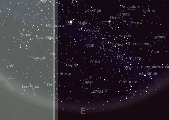 | 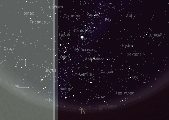 | 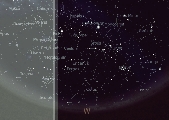 | 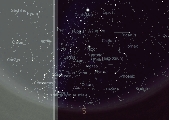 | chart for the eastern horizon (with the Milky Way-embedded constellations), the great winter sky on the northern horizon, the western horizon, and the southern horizon. retrieve the printer-friendly equivalent of those charts: (eastern horizon with the Milky Way-embedded constellations, great winter sky on the northern horizon, western horizon, southern horizon) |
Those two hemispherical maps are a further bonus with the pack. Such hemispherical sky charts are much usual tools with amateur astronomers. With a limiting magnitude of the 6th magnitude, they provide a comprehensive view of both the northern and southern parts of the celestial sphere, allowing for some swift check of a position or the general approach of the whole celestial sphere
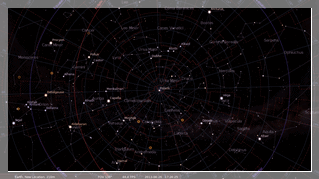 | 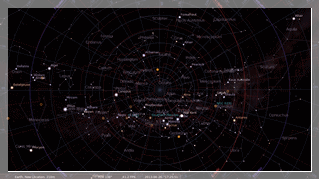 | click on the chart (left) to a northern hemispherical sky chart or the chart (right) to a southern hemispherical sky chart |
->Feeling interested by the hobby? See more subjects, and detailed studies, at the site 'Amateur Astronomy'!
Website Manager: G. Guichard, site 'Amateur Astronomy,' http://stars5.6te.net. Page Editor: G. Guichard. last edited: 12/28/2010. contact us at ggwebsites@outlook.com